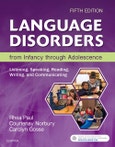- Clinical application focus featuring case studies, clinical vignettes, and suggested projects helps you apply concepts to professional practice. - UNIQUE! Practice exercises with sample transcripts allow you to apply different methods of analysis. - UNIQUE! Helpful study guides at the end of each chapter help you review and apply what you have learned. - Highly regarded lead author who is an expert in language disorders in children provides authoritative guidance on the diagnosis and management of pediatric language disorders. - More than 230 tables and boxes summarize important information such as dialogue examples, sample assessment plans, assessment and intervention principles, activities, and sample transcripts. - Student/Professional Resources on Evolve include an image bank, video clips, and references linked to PubMed. - NEW! Common core standards for language arts incorporated into the preschool and school-age chapters. - NEW! Updated content features the latest research, theories, trends and techniques in the field. - Information on preparing high-functioning students with autism for college - Social skills training for students with autism - The role of the speech-language pathologist on school literacy teams and in response to intervention - Emerging theories of etiology and psychopathology added to Models of Child Language Disorders chapter - Use of emerging technologies for assessment and intervention
Table of Contents
Section I: Topics in Child Language Disorders 1. Models of Child Language Disorders 2. Assessment 3. Principles of Intervention 4. Special Considerations for Special Populations 5. Developmental Language Disorders in a Pluralistic Society
Section II. From Birth to Brown's Stage V 6. Assessment and Intervention in the Prelinguistic Period 7. Assessment and Intervention for Emerging Language 8. Assessment of Developing Language 9. Intervention for Developing Language
Section III. Working with Language Learning Disabilities 10. Language, Reading, and Learning in School: What the Speech-Language Pathologist Needs to Know 11. Assessing Students' Language for Learning 12. Intervening at the Language-for-Learning Period 13. Assessing Advanced Language 14. Intervention for Advanced Language
References Name Index Subject Index








